From Issue Seven of Gear Patrol Magazine.
WWhen I was a boy, I learned from my late uncle — the owner of a string of high-performance and very desirable cars — a trick for falling asleep. Think of something abstract, he told me, a manufactured, waking dream. You’ll quickly drift to dreamland. If you think of something real, like your next day’s schedule or a dinner party conversation earlier that evening, your mind can’t release into slumber. His method works well, as I’ve discovered through half a lifetime or more of restless and anxious attempts at sleep. But I recently ruined my go-to abstract dream-lullaby in the parking lot of a Northern Michigan Applebee’s.
It was after midnight. I was buzzed on Bell’s beer and waxing philosophical about the same cars I’d been pre-sleep dreaming about for decades — because I’d just driven them all 1,000 miles through my home state. “Eatin’ good in the neighborhood” hadn’t been my Last-Supper plan to commemorate circumnavigating most of Michigan. If our crew had wrapped the day earlier, perhaps we’d have found a venue more appropriate for the vehicles we’d just piloted and photographed for the previous four days. A venue where three magnificent, top-end, top-dollar, archetypal “baller” cars might not have been so out of place. Indeed, even if I had a dollar for every boneless buffalo wing I’d inhaled in my life, I couldn’t come close to a down payment on these cars. But price alone isn’t enough for a motor vehicle to achieve waking-dream status, anyway; no, these particular cars are a higher breed. They belong to the grand tourer genus, a nearly intangible echelon of vehicle that, especially in the age of the quickly evolving automobile, demands examination.
Grand tourers (in which one goes “grand touring”; also called “GTs”) are, in the automotive world, the epitome of style and design — the ultimate form of rolling luxury. To me, a car-geek kid turned car-geek thirty-something, that belief has always been canon. Ultra-luxury chauffeur-driven sedans and $1.5 million hypercars are, indeed, over-the-top indulgences, the most hyperbolic of automobiles. But a grand tourer is more than a machine with massive performance cred and a price to match. It’s more than a bejeweled luxo-barge. It’s more than a daily drivable golf-bag caddy, more than a technological powerhouse, more than a stunning work of design.

A grand tourer is, by necessity, all of those things in one. A grand tourer must have a larger-than-necessary high-performance engine and be comfortable enough for long-distance trips; it must have only two doors, with rear seats optional; it must maintain perfect proportions, with graceful lines and wide hips and a powerful stance. And let me be perfectly clear: grand tourers aren’t sports cars. They’re sporting cars.
Because it checks all these boxes, a grand tourer is partially a compromise by a thousand cuts. Throw all those extreme qualities into the same car then dial them up all the way, and you’ve got the beautiful antithesis of practicality. All grand tourers share specific characteristics, yet fall along a wide spectrum, ranging from very luxurious and complex on one end to simple and lithe on the other. To tell this story, we brought along three models — the Lexus LC 500, Aston Martin DB11 V12 and Mercedes-AMG S65 Coupe — that represent waypoints along that spectrum.
I enlisted some of the best minds in the biz to help me test these cars and pontificate on the spectrum itself: crack auto journalists Eric Adams and Alex Kalogianni and the ferociously talented automotive photographer Dave “DW” Burnett. Eric and I have worked together for years now; his automotive, aerospace and tech reporting appears all over the Gear Patrol universe and beyond. Alex and I met recently on a similarly epic road trip through Europe; he is a formidable automotive expert, having edited, written and opined on video about the industry for years. Dave’s work graces the pages of such publications as Road & Track, Vanity Fair and many others. And, I discovered, they’re all hyperactive opinion factories.
So then how do each of these cars of ours avoid being, as Dave put it, “a finely tuned experience for people who maybe understand what going fast is like,” and instead allow a driver’s skill and enthusiast spirit to shine? We would exercise a combined 1,692 horsepower and around $600,000 worth of GT machinery over four days and 1,000 miles to find out. Not to choose a winner, but to understand the essence of the contemporary grand tourer.
More immediately, though, why put the Grand Tour Philosophy to the test in Michigan? Why drive three cars that have nothing to do with the state’s — let alone the country’s — deeply historic auto industry through the Motor City and beyond? Several reasons, mostly selfish: I’m proudly from Michigan (you could say I’m #PureMichigan, in fact); Michigan is unbelievably gorgeous on every level; Detroit was a great meeting point for us all; and… I kind of wanted to park an Aston Martin in my parents’ garage for a night. After all, I’d drifted to sleep on that notion for decades, and now I had a chance to make my hazy fantasy an acute fever dream.
Day 1 — Detroit to Muskegon, 200 miles
After pre-dawn alarms, taxis, a TSA drug dog incident, a few flights out of the greater New York area and a Detroit airport shuttle, we convened at an off-site parking lot where our touring trio awaited. Cold and still, the cars waited patiently but expectantly, like medieval war steeds just before a long campaign; we approached like sweaty and already travel-weary knights of the Grand Touring Table.
I’d promised Dave plenty of room for photo gear in the Mercedes — after all, as a sedan-made-coupe, I thought it would have a cavernous S-Class-sized trunk. So imagine our surprise when we found a sizeable back seat-accessible refrigerator taking up valuable storage real estate (“the most disappointing part of the trip for me,” Dave would claim later as we debriefed). We hadn’t started a single engine, and already the Benz was vying for the designation of most opulent, perhaps to a fault. The Aston, at 10 cubic feet, and the Lexus, at only five, have just enough trunk space between them for a moderate golf bag and a few duffels. But, coupled with the Mercedes’s adult-sized back seat — in contrast to the less-than-reasonable back seat space in the Lexus and the Aston’s complete lack of a rear seat — all the excess legroom gave us plenty of room to pack Dave’s gear and set off for the heart of the city.
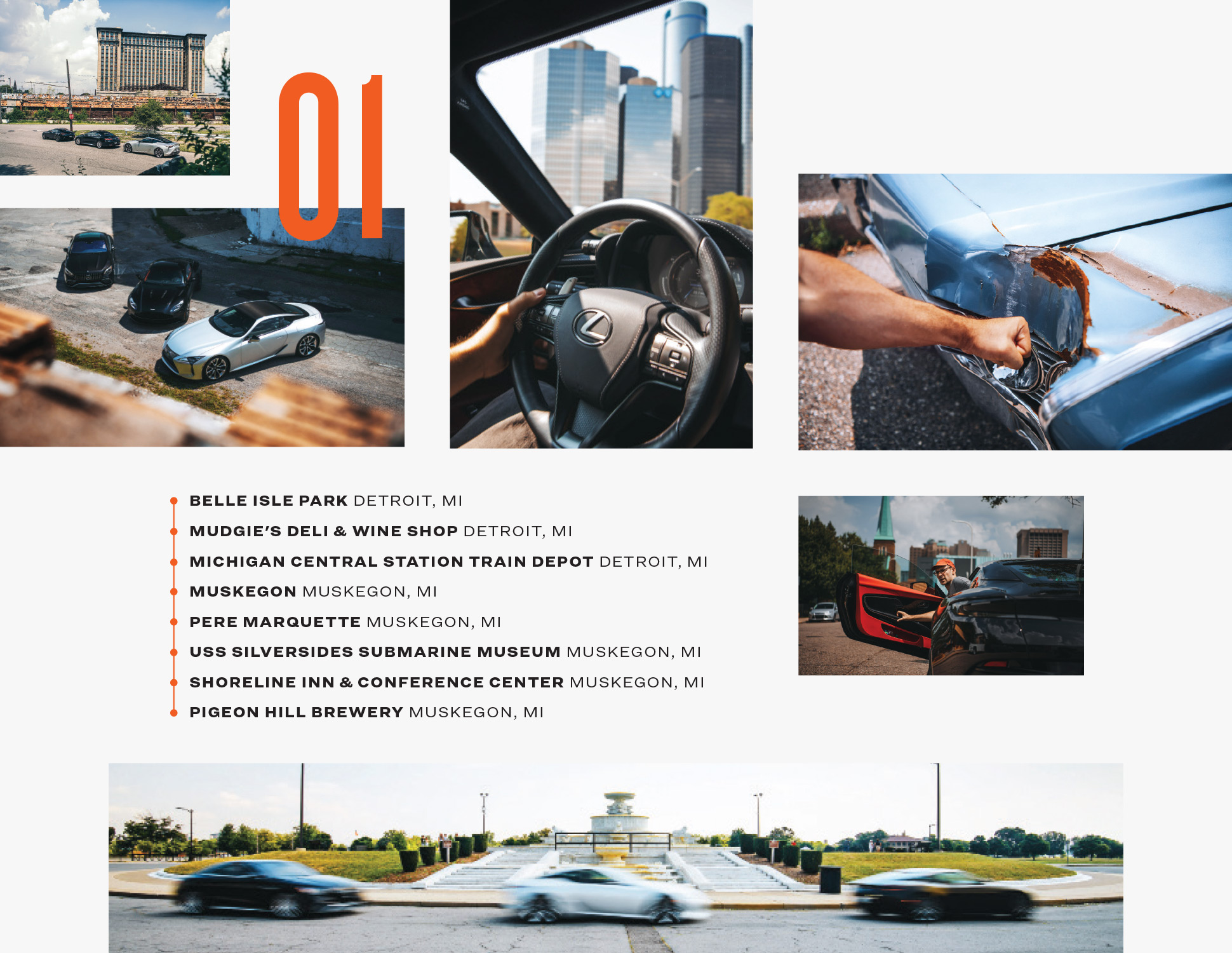
After a quick briefing, we saddled up and took off immediately for Belle Isle, a 1,000-acre island park situated right between Michigan and Canada in the middle of the Detroit River. It was high noon and sticky-hot in the vast, still park where, among its meandering roads, we found an inactive marble fountain for our glamor-shot debut.
Alex, a Mustang owner, was immediately at home in the Lexus. “My short one-sentence review of the LC 500 is that it’s the most expensive Mustang I’ve ever driven,” he told the group.
Dave echoed his high praise: “The LC punches above its weight. We can take it on a trip like this with cars more than double its cost and it’s hanging.”
Indeed, in that way, Lexus has made the entry-level car of the GT pantheon, if you can consider $100,000 “entry level.” Were I personally unable to swing an Aston Martin, I’d pick up an LC 500 and feel fine about my purchase — at least partially because, at full tilt, its big V8 sounds like an insane gasoline-gulping banshee.
But if I could drop a quarter-million dollars on a DB11 V12, nothing on earth would stop me. Every time I drive one, it feels menacingly familiar, maybe like Bruce Wayne feels when he slips into the bat cowl. It’s an objectively spectacular feat of automobile design, engineering and manufacturing. Eric described it as the “skittish thoroughbred” of the group; “You feel like you have to perform for it,” he said. True, the DB11 is always “on,” and when driving one, so must you be, too. I find that sensation intoxicating and seductive, but it’s not for everyone.
Initial thoughts on the S65 were myriad, but all seemed to cement it early on as occupying the far, opulent and majestic end of the spectrum. “It’s like the minivan of the trip,” said Dave, as an honest compliment — relatively, there is so much room and such a vast array of conveniences that it was the long-haul choice straight away. Initially, I found it overwhelmingly confusing to operate, for the most part; but that impression faded even in the short time I spent with the car. It is, plainly put, a pleasure to cruise in.
After wrapping our first shoot, opinions developing with rapidity and stomachs alive with audible growls, our $600,000 caravan wound its way through the Motor City in search of food. We found it at Mudgie’s Deli in Corktown, where, over spicy noodle salad and huge sandwiches, conversation flowed as we planned our next move.
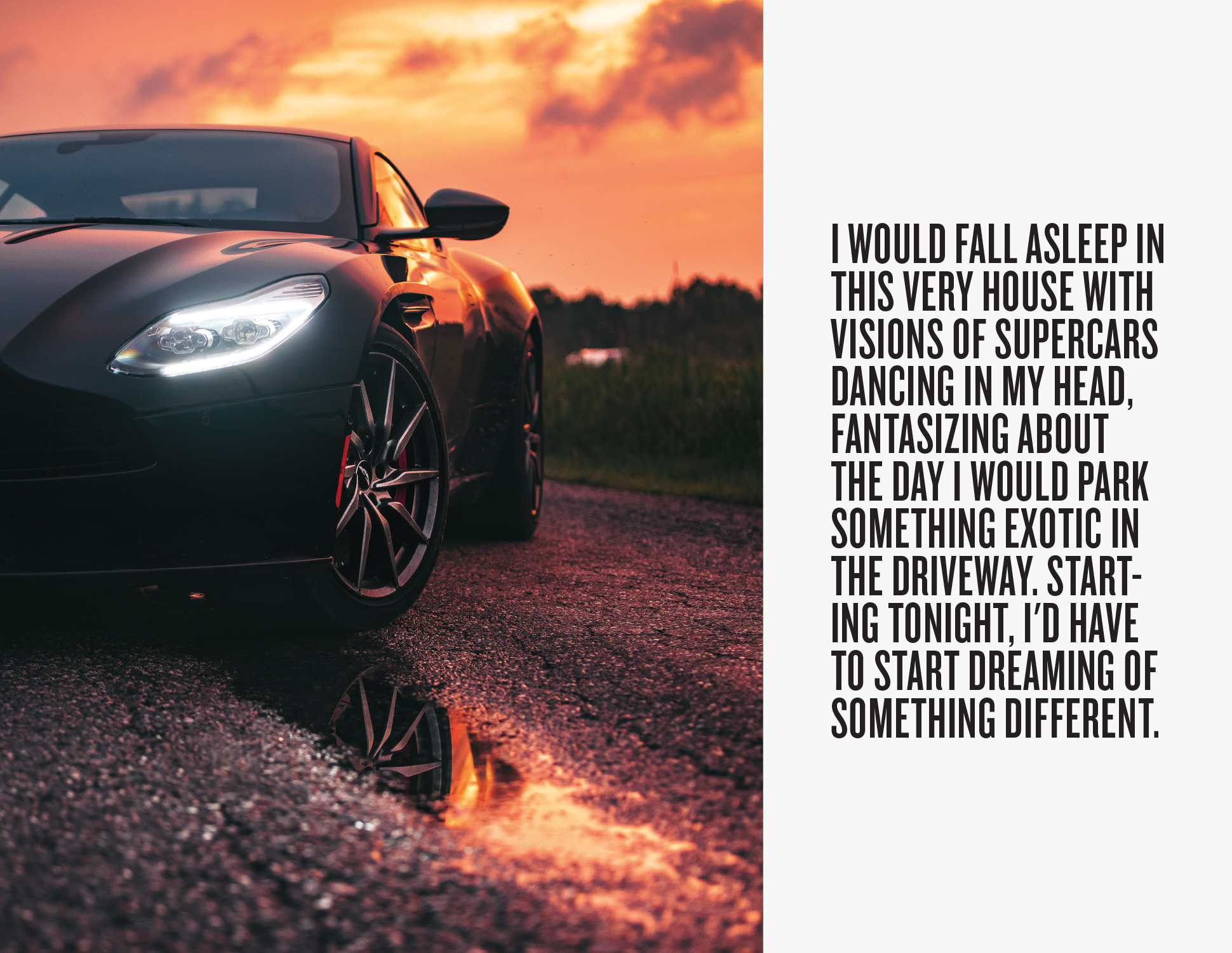
Detroit is quickly overcoming its fraught history. After a decades-long downturn, ignited in part by the automotive industry moving its manufacturing beyond the city and out of the U.S. entirely, entrepreneurs and the younger generation have found new roots, creating housing opportunities, jobs and commerce among the relics and ruins of the old city. There is, as you might imagine, much to photograph there, though we were going straight for the belle of the ball. Michigan Central Station, an abandoned, looming train hub that stands like a time machine in the middle of an evolving metropolis, was recently purchased by the Ford Motor Company for revitalization and preservation. The building is epic to behold and rife with photogenic vantage points, and as we flagrantly staged photos and blocked streets for prime angles, we drew plenty of attention, including that of a cop.
As his patrol car approached, we disbanded; he pulled up next to the Aston, glared, and I steeled myself for the worst. I rolled down my window, and without breaking the scowl on his face, he boomed, “Which one’s the fastest?” Then flashed a massive smile and offered to help us however possible, going so far to say he’d alert the precinct that we weren’t causing trouble and thanked us for choosing his city to feature in our story. Detroit gets a bad rap for its history; not only is its future bright, its present is, too.
Our day only half over, we bid adieu to the state’s re-budding metropolis and shot westward toward my hometown, Muskegon, on the Lake Michigan shore. The familiar three-hour drive gave me time to reacquaint myself with the sublime DB11, a car that’s at once taut and sinewy to its core, but also supple and plush.
I entered this GT showdown with the working theory that the Aston is the quintessential example of this kind of car. Not all my companions were totally sold.
“My problem is the usability of the car compared to the other ones,” Eric said. “There’s no real cupholder. No convenient place to put my phone. You don’t feel like you’re really inside something special. I don’t mean it has to be eye candy everywhere, but it just has to have a little energy to it, and I don’t get that on the inside.”
That’s by design, Dave countered. “You’re having the experience that Aston wants you to have, and I kind of get that. If you put other stuff on a car like that it’s like putting a fanny pack on a tuxedo.”
Trying to keep my bias in check, I showed off Muskegon’s sights: a World War II submarine; the lighthouse-studded, sandy lakeshore (where a boy walked by and asked if any of our cars had “doors that go up”); a classic West Michigan sunset. Afterward, I checked the guys into the Shoreline Inn, which overlooks downtown and the inland Muskegon Lake, and headed home with my Aston.
Decades ago, I would fall asleep in this very house with visions of supercars dancing in my head, fantasizing about the day I would park something exotic in the driveway. After I burbled into the garage with the DB11, and my dad emerged from the house already snapping photos, it hit me. Starting tonight, I’d have to start dreaming of something different.
Day 2 — Muskegon to Glen Arbor, 148 miles
During a leisurely morning with my parents (plus a curious neighbor who popped in to offer us “twenty grand” to take the Lexus off our hands), we discussed and debated the state of the grand tourers.
First, the Mercedes-Benz, with its 6.0-liter twin-turbo V12. Twelve-cylinders are signature elements of the classic GT car, Dave pointed out. “It’s not a sports car engine. It’s an oil tanker. That’s why it’s in the G65 [SUV] and that car. It just torques the earth around.” My feelings exactly: with 621 horsepower and a truly mental 738 lb-ft of torque, the earth moves for Mercedes. But do wealthy bankers actually need to be carving corners, or do they just want to go fast sometimes? “The guys who buy these probably get as much sportiness as they’re looking for,” my dad noted. “They’re not taking it on a gymkhana.”
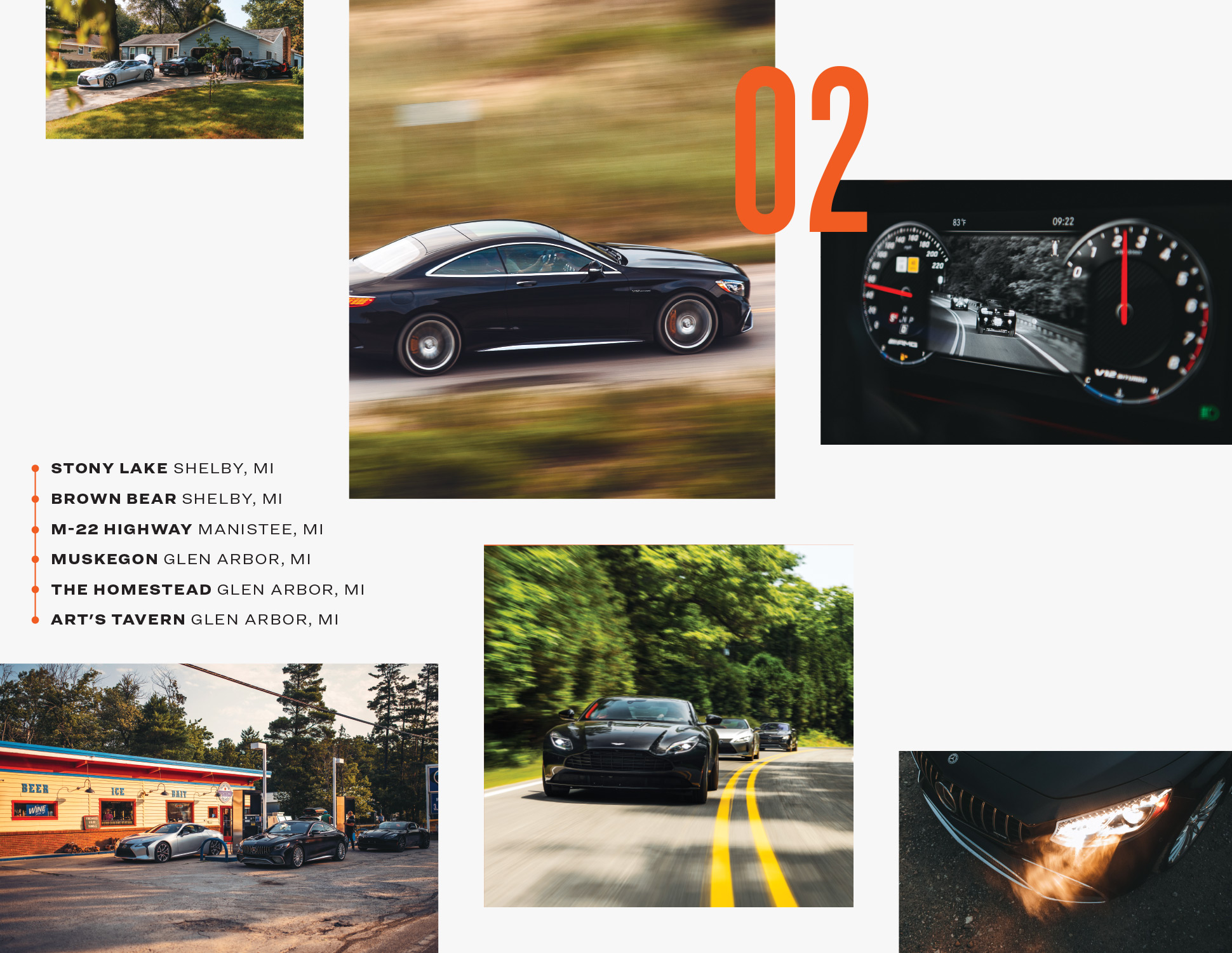
After a long goodbye, we shoved off for a quick drive north to Stony Lake. My brother and his family were spending a few days at our lake house before the school year began, and, aside from wanting to get in a couple hours of quality time, I needed to recruit a camera car (my sister-in-law’s Explorer), a copilot (my 11-year-old nephew) and a driver, my brother Matt. His skills honed by years behind the wheel of an ambulance, my brother was more than up to the task of bombing down the oncoming lane so Dave could perform insane acrobatics to procure photos. It helped, of course, that as a teenager Matt would drive in the empty opposite lane screaming “we’re in England!” to scare me senseless — a skill allegedly passed down to him from our oldest brother, Chris.
The roads around Shelby, Michigan, are mostly arrow-straight paths through acres of farmland where grassy asparagus and rough cherry trees grow in massive patches across the entire landscape. You can see for miles down those roads, and the colors of the hay and trees and sky beat like America’s heartland — it’s a magnificent place. And good exercise for big engines to reach passing speed around tractors and slower, loping locals.
My nephew, who has soaked up a love for fast mechanical things, was wide-eyed at the sight of our high-dollar, high-performance herd. He first rode with me in the LC 500, which he claimed was his favorite; after a fast run in the DB11, he naturally changed his mind. Then he rode with Alex in the S65 and didn’t look back. Won over by the endless gadgets and gizmos, like the glass roof and the refrigerator and the night vision and the colored LED lighting system, he’d found the modern preteen automotive dream: a playground of tech on four wheels. As I understand it, he went on to lecture about the merits of Mercedes-Benz for days afterward.
My whole family was taken by it, actually. Dad was amazed by the Mercedes’s dimmable electrochromic glass roof, which changes from a light to dark blue shade should you wish to shun the sun; Mom and I closely inspected the car’s scent diffuser together. The S65 is an astonishing car, magnificently plush and so laden with technology that it would be at home in a sci-fi blockbuster.

Truth be told, it’s probably the most complicated car I’ve ever driven, and getting behind the wheel was a mini dream come true. The V12-powered Mercedes-Benz coupe was the first “fuck you” car I ever knew existed. As a budding auto enthusiast about my nephew’s age, I first figured out the excess — the non-necessity — of the early ’90s CL 600 and understood that other cars were made in its image.
But the S65 stirred contention among our ranks. “With the LC, you get a sense that there’s real deep-tissue design going on there in the architecture,” Eric said. “It’s the only one [of our three] that wasn’t a clean sheet design for the intent of a coupe. I have great respect for this car, but it does not feel like a $239,000 car. I’m sure it is, but if they were to set out with that budget and these performance parameters and design a coupe, would it be this car?”
“No. It would be something else,” Alex said.
Or, as Dave put it: “By cutting doors off, It’s like they sort of targeted a demographic… like the millionaire on Bumble or something.”
With sparse cell reception, no one was using Bumble out here in the country anyway. And, with their duties done, we parted ways with my family and recharged at the Brown Bear, the bar and restaurant with the best burgers in the state.
After a time-consuming morning, the rest of the day would be occupied by a winding drive along the West Michigan coastline and a search for stunning views and photo opps among the dunes and cliffs of scenic route M-22. Our destination for the night was Glen Arbor, a tiny town on the Leelanau Peninsula, adjacent to the utterly magnificent Sleeping Bear Dunes National Lakeshore. Under cover of night, we arrived at our stopover: the Homestead Resort, where a four-person lakefront condo awaited us. Though it’s a full-service resort with restaurants and spa, our time was limited; we had an entire state to cover. After scaring up some grub at Art’s Tavern — a college pennant-covered, Michigan beer-saturated restaurant popular with locals and vacationers alike — we hit the hay.
Day 3 — Glen Arbor to Sault Ste. Marie, 259 miles
After breakfast and a quick car wash to brighten our chariots (“No towels? Oh shucks, we’ll have to air dry…“), we headed straight to Traverse City, one of the better-known spots along the northern tip of Michigan’s lower peninsula. It’s a summer vacation destination with sweeping views of Grand Traverse Bay, which feeds off of Lake Michigan and points straight north toward the Upper Peninsula (pro tip: locals call it the “U.P.”). It’s a quick stop, inundated by curious onlookers held rapt by our unfamiliar machines. As I drove through a parking lot, a man walked right up to the Lexus and began screaming with his arms outstretched, apparently concerned neither with his safety nor the fact that he looked deranged. I rolled down the window and he exclaimed again, as his wife shrunk away, “What IS this? It’s BEAUTIFUL!” Small crowds gathered around the Aston Martin, too, and the Mercedes drew some beguiled glances.
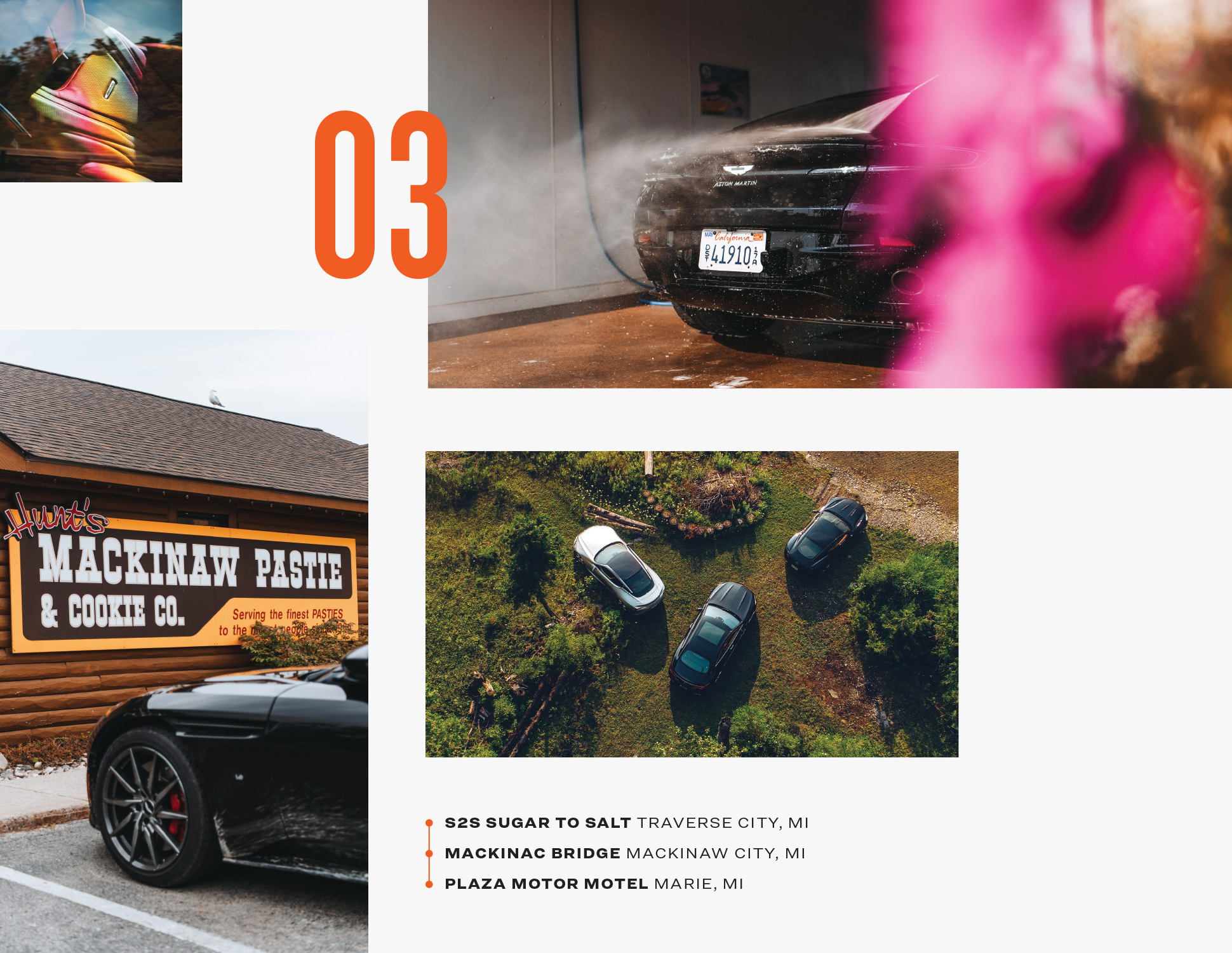
Rabid fans aside, we had miles to go before we rested, and heavy rain clouds quickly approached from the west. We were chasing sunlight and dry roads. Our destination, the far edge of the Upper Peninsula, was hours away.
The Mackinac Bridge is a nearly five-mile stretch of proud, tall civil engineering conjoining the two very disparate parts of Michigan. Whereas the Lower Peninsula is full of metropolitan cities and seaside resort towns, the U.P. is largely a quiet place set upon by extreme winter weather and full of vast swaths of forest. Scattered throughout are smaller towns and some cities, like Marquette, Escanaba and our home for the night, Sault (pronounced “soo”) Ste. Marie.
Massive bolts of lightning began striking the bridge when we were only a few minutes away. White cracks of light split swirling, midnight blue swirling skies as larger and larger raindrops activated our automatic windshield wipers. Were the rain to start in earnest and keep up, our plans for bridge photography would be ruined. And so, as we rolled onto the south side of the span, the merciless sky burst open and dumped an entire Great Lake’s worth of rain.
And then, as we crossed through the toll booth, a meteorological miracle: the rain stopped completely.
Navigating into Bridgeview Park to the northwest of the Mackinac, we watched as skies brightened, yellowed and cleared. We were alone in the park, with nothing but a majestic suspension bridge backdrop, a world of photographic possibility and enough humidity to require SCUBA training. Elated and emboldened by our luck, we followed Dave’s hunch and went exploring in the U.P.
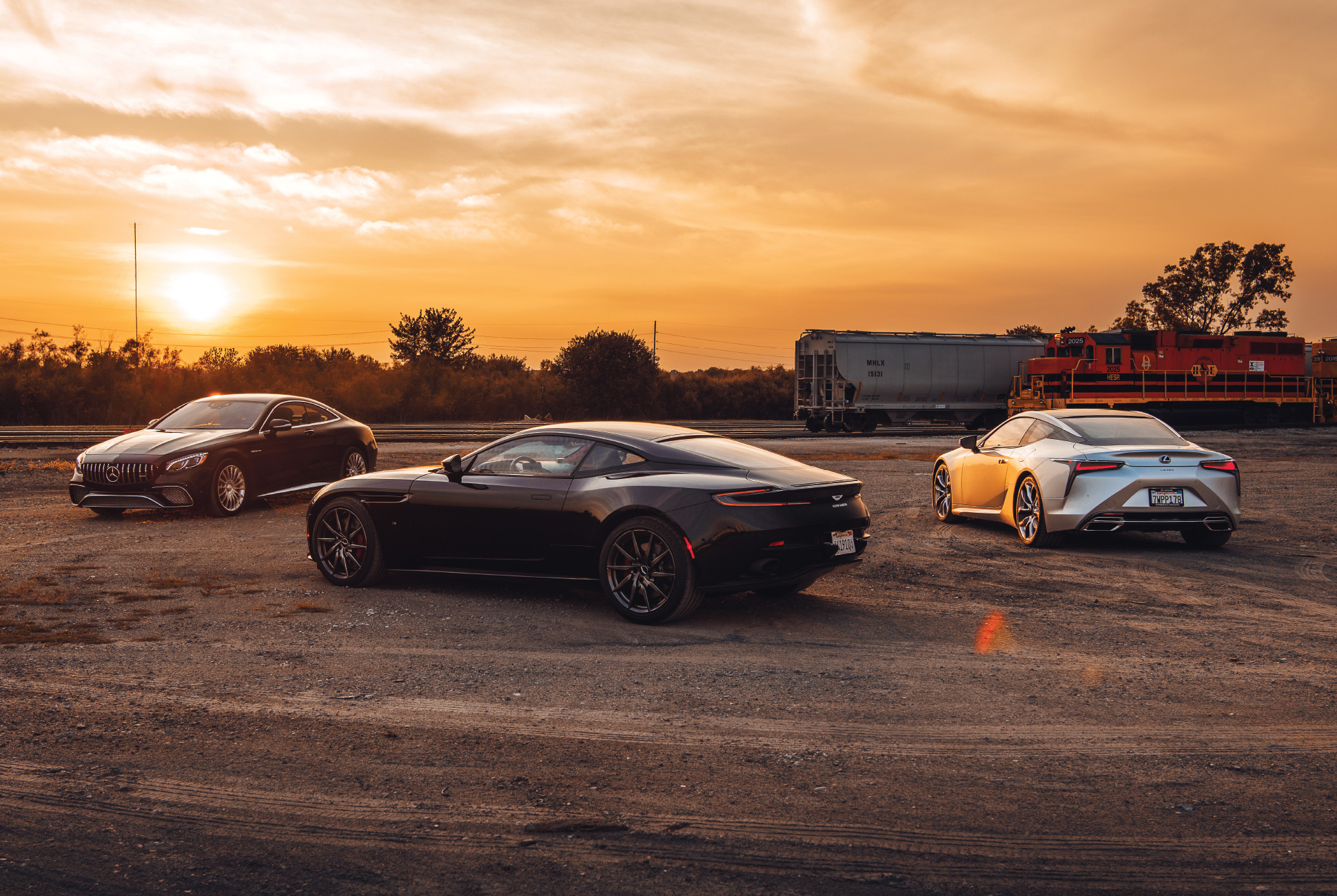
There’s a small town named (very appropriately) De Tour Village tucked in the far southeastern corner of the U.P. We found our way to a sparsely occupied point overlooking St. Mary’s River, which serves in part to connect Lakes Huron and Superior in the space between Michigan and Canada. I have no scientific basis for this claim, but I am certain in my heart that never before has there been, and never again will there be, a grouping of these three vehicles on that point. I can, however, definitively state that the Aston Martin DB11 can handle light off-roading.
Our photo cup overflowing, we doubled back and headed north to Sault Ste. Marie just as the sun was beginning to glow a gorgeous amber over the farmland horizon, providing us, almost too perfectly, with a final photoshoot for the trip.
After checking in to the the Plaza Motor Motel, a throwback motor lodge so far north that Yelp suggested Canadian restaurants while we were there, we explained our cars to curious motel neighbors and set out for the open-late godsend that is Applebee’s, where all but one of us guzzled Michigan beer as the whole crew discussed our grand tourers until well after closing time.
Day 4 — Sault Ste. Marie to Detroit, 353 miles
We didn’t have much time the next day and, frankly, we didn’t need it. Photos complete, and our destination checklist totally crossed off, we only needed to head back to Detroit and fly away.
The previous night, as we stood in the Applebee’s parking lot, volleying opinions and arguments, several definitive conclusions emerged. When I asked the guys to pick their favorite among the three, we unanimously voted for the Aston. “But,” Dave said, “it’s not a fair fight.”
Yeah, it’s rigged. The Aston is, as Eric later put it, a “rare bird.” It’s exotic in a way the others aren’t — it’s handbuilt, it’s 007’s choice, it’s among the most beautiful cars on the road. “If it’s my own money… I’d probably go for the Mercedes,” Eric said. “I’m a closet bling hound. It’s got those wheels, it’s got that chrome trim. I dig the LED color-changing thing inside. It’s got shiny things inside and out, and I like that. If I wanted a car I could go out in on the weekends and do the occasional trip with my wife, then yeah, the Aston.”
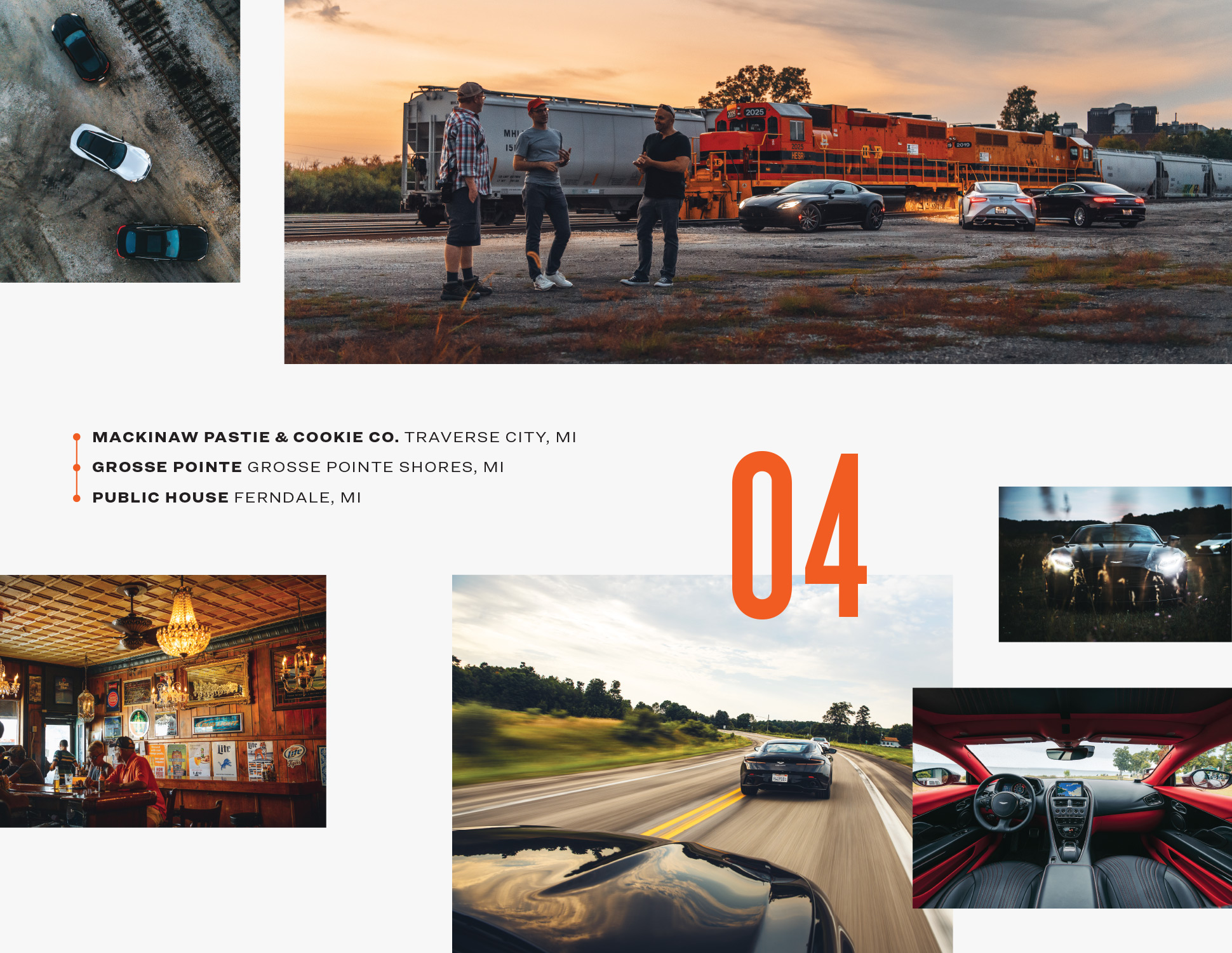
“[The S65] is the only car of all three that can do the pure-luxury thing,” Dave said. “The Lexus could be a daily driver, but it’s not gonna be. You can’t throw something in the back seat. That’s why I’m riding in the Mercedes all day: my gear. But German engineers are gonna win every time. They’re going to turn everything up to eleven. I need a car that kinda sucks sometimes so I can love the parts that are great.”
Personally, I’m still torn. The DB11 V12 is a monumental car that means a great deal to me. I would love to own one. Then again, I can’t conceive of having a quarter-million dollars, let alone paying that much for… anything. But the Lexus is just such a gem. It’s light and lithe and comfortably simple, yet it delivers all the kinds of tech conveniences and modern enjoyment one might want. We all agreed that it’s the satisfying, perfect culmination of Lexus’s sometimes quizzical design exercises over the past five to ten years; all the brand’s visual cues work incredibly well here. Plus, it’s got reliable Toyota DNA and a relatable, sonorous V8 engine. In Detroit, a guy in an old Suburban stopped traffic to pull next to me and say, “I’ve been doing exhaust work for thirty-five, forty years, and you sound pretty good, brother.” It’s superb, and I’d be tempted if it were at all possible.
Alex wasn’t backing down. “The DB11 suits me. It needles you a little bit. It’s a super tight, super rigid experience. It’s not as nice ride-wise as the Mercedes or the LC. And even some of the conveniences aren’t as good. When I got bored, I turned on Sport mode. In the other cars, when I got bored, I was looking for another radio station.”
“You were driving,” Dave replied.
There it is. Driving. Grand tourers aren’t made for drag strips or gymkhanas. They’re not made for cruising Rodeo Drive or parking at your lake house. They’re made to extract the very best out of the driving experience. People notice these cars, partially because they look athletic and aggressive (as Dave pointed out, there’s chain mail on the front of the S65), and because they look opulent. But they make people happy because they look like emotion; they look like what it is to love the art and act of driving.
“All three absolutely satisfy the nebulous qualities of a GT, but at different ends of the spectrum,” Alex said. The relatively simple, light and beautiful Lexus balances out the heavy, plush, computerized Mercedes-Benz. The aggressive, sultry Aston Martin is in the middle somewhere. And so, the unsatisfying but entirely philosophical conclusion is that there isn’t a definitive choice here — not that we set out to find the “best” among these three anyhow.
The best grand tourer is what speaks loudest and most directly to the driver’s enthusiasm for driving. Do you require German opulence and locomotive torque? English aesthetics and brutish muscle? Japanese serenity and fine design? It really all comes down to whatever helps you sleep at night.
Editor’s Note: minor adjustments have been made to this story in order to accommodate online publishing.
Special thanks to the Michigan Economic Development Corporation.

